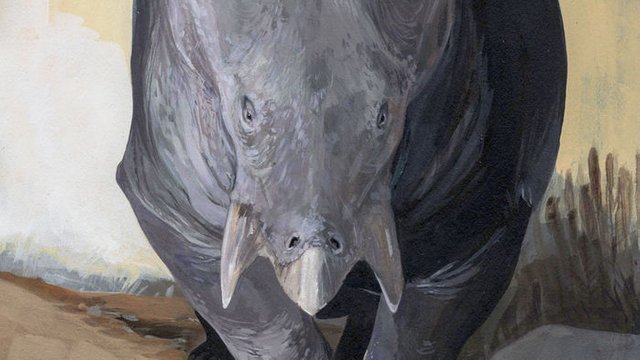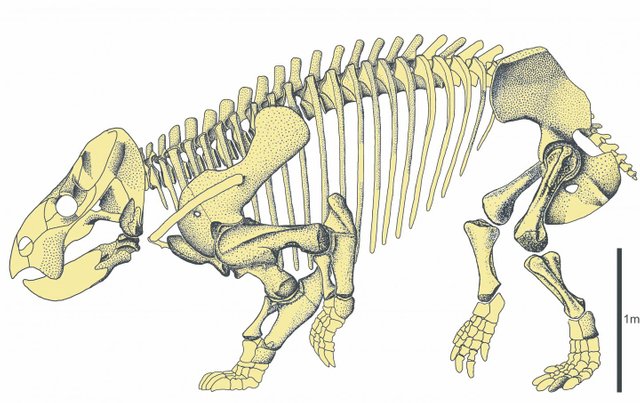Lisowicia bojani: A Rhaetian Triassic, Elephant-sized Mammal Relative that Coexisted With Dinosaurs

image credit: KAROLINA SUCHAN-OKULSKA
There is no question that during the Mesozoic, dinosaurs became the dominant form of life. The geological era has even been nicknamed the "Age of Dinosaurs." However, in the beginning period of the Mesozoic, the Triassic, the dinosaurs did not start out as the dominant form of life. There were several other types of large life such as large life forms like phytosaurs, pseudosuchians, dicynodonts, and other therapsids. How and why the dinosaurs became dominant has been contested and argued over for longer than a century. A new fossil upends some of the hypotheses about what was happening and why.
The last stage of the Triassic is called the Rhaetian and named for where it was originally found, the Rhaetian Alps. The rock formations there were distinct from those above and below. That stage of the Triassic only lasted for approximately seven million years, a geologically short time frame. The stages preceding the Rhaetian were the Norian (lasting about 9 million years and the Carnian which lasted about ten million years).
From the Carnian and earlier, dinosaurs were just one type of animal amongst several. In fact, the dinosaurs had several close relatives called the dinosauromorphs that had similar, but not exactly the same such as the poposaurs and silesaurs. There were also pseudosuchian archosaurs, like Postosuchus, converging with the theropods.
One of the competitors to the early herbivorous dinosaurs were what has been incorrectly called the mammal-like reptiles or more accurately, the therapsids. These relatives of mammals had formerly been dominant in the ecosystem prior to the Permian Extinction. After when life almost died, some of the types of therapsid survived and were important parts of the ecosystem. Most notably, dicynodonts were very early and important members of the ecosystem right after the extinction and would continue to be until the Carnian. Then something happened.
At the end of the Carnian, many of the therapsids declined in importance. It appeared that many of the carnivore and herbivore therapsids went extinct and were replaced by various archosaurs. There have been ideas as to why. Some have argued the shift from the very arid to extremely wet to very arid climates might have caused the extinction. The Carnian Pluvial Event was extreme enough and wide spread enough to have caused extinctions.
However, one of the banes of science is the lack of sufficient samples. Paleontology suffers from this especially since fossil sites from a given time frame are often rare. Sometimes single locations can have their environment change, areas can dry out, an animal will leave that area, but lives on elsewhere. Yet, if that fossil site is the only one or one of very few, it might be the taken as the animal has become extinct even though it merely moved elsewhere. Bison used to be present in Southern California, based on the La Brea Tar Pits, but now do not live in the Golden State. If all you had were the La Brea Tar Pits, then you would assume bison were extinct. That same sort of thing might have happened to animals during the Triassic.
In Poland, researchers from Uppsala University, found the largest dicynodont ever. Lisowicia bojani appears to be nine tons. The previously largest dicynodonts found were approximately 1 ton: Placerias from Arizona, was roughly the same size as a large bull. Lisowicia is roughly the size of an elephant. The ancestors of the long necked sauropod dinosaurs were growing large at this point. It is now thought based Lisowicia that dicynodonts might have been doing the same. The reason suggested is protection from carnivores: a big animal is far less likely to be taken down by predators since it is so dangerous for the predators.
Like all dicynodonts, Lisowicia had a beak and lacked teeth. Had there been a person alive to see the beast it would have been a strange sight. As big as an elephant, it's legs were beneath it like modern mammals, but it's mouth would have had a weird beak on it with potentially only two tusks and no teeth. Dicynodonts used a weird grinding mill with their jaws to chew and it would have looked like Lisowicia was jutting its lower jaw forward as it did so. It would have been a bizarre sight to behold.
Lisowicia also dates from the Rhaetian, the final stage of the Triassic. Dicynodonts might not have been going extinct, but rather may have moved from the sites where fossils have been most commonly found for environments more favorable to them. If so, the idea dinosaurs outcompeted the other types of fauna may be incorrect. There was a hint of this with the disputed discovery of a dicynodont from the Cretaceous of Australia.
Additionally, Lisowicia casts significant doubt on the idea the paleoatmosphere had a massive drop in oxygen levels during the Mesozoic, at least during the Triassic. Some had hypothesized based on proxy evidence that oxygen levels dropped wildly during the Triassic leading to the dinosaurs and their efficient breathing system becoming dominant. However, with a dicynodont being so large, it becomes almost impossible for that to be the case: dicynodonts had a breathing system similar to mammals and since Lisowicia was so large, there had to be enough oxygen to support the beast.
As the researchers stated, Lisowicia was the find of a life time. It is also helping to completely rewrite what we thought was going on during the Triassic and it seems increasingly likely that had the Triassic/Jurassic Mass Extinction not taken place more than a tuatara-esque survivor dicynondont would have participated in the middle and late mesozoic ecologies.
An elephant-sized Late Triassic synapsid with erect limbs
http://science.sciencemag.org/content/early/2018/11/19/science.aal4853
A giant in the time of dinosaurs: Ancient mammal cousin looked like cross between a rhino and a turtle
https://www.sciencemag.org/news/2018/11/giant-time-dinosaurs-ancient-mammal-cousin-looked-cross-between-rhino-and-turtle
Gigantic mammal 'cousin' discovered
https://www.eurekalert.org/pub_releases/2018-11/uu-gm112118.php
Elephant-sized Triassic creature sheds new light on old theories
https://www.eurekalert.org/pub_releases/2018-11/aaft-etc111918.php
Giant mammal cousin rivaled early dinosaurs
http://science.sciencemag.org/content/362/6417/879
Once Upon the Permian: Beaked Bites of a Lost Lineage
http://thedragonstales.blogspot.com/2008/03/once-upon-permian-beaked-bites-of-lost.html
Dicynodont
https://en.wikipedia.org/wiki/Dicynodont
Therapsid
https://en.wikipedia.org/wiki/Therapsid
Late Triassic
https://en.wikipedia.org/wiki/Late_Triassic
Carnian Pluvial Event
https://en.wikipedia.org/wiki/Carnian_Pluvial_Event
Placerias
https://en.wikipedia.org/wiki/Placerias
Dicynodonts that didn’t die: late-surviving non-mammalian synapsids I
https://darrennaish.blogspot.com/2006/05/dicynodonts-that-didnt-die-late.html
Gasping for Paleo Air
http://thedragonstales.blogspot.com/2008/10/gasping-for-paleo-air.html

It always amazed me how from the far long Dicynodont era, that bulky for-legged body plan has always found large amount of succes amont land creatures, most of the terrestrial animals hav adopted this at some point of their evolutuinary path, it is so nuts how evolution pushes creatures to the easiest ways of succes well, mostly lol
Mother nature likes to recapitulate a lot of her patterns. The dicynodonts, rhynchosaurs, ceratopsians and rhinos. Or sharks, ichthyosaurs, mosasaurs and dolphins. Or pterosaurs, birds and bats.
Yeah, convergent evolution is so fucking crazy!
Rinse, lather, repeat.
It makes you wonder how deep the divergence has to be before we don't get parallel evolution. However, form follows function.